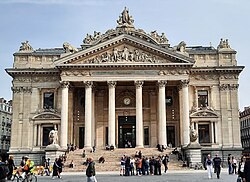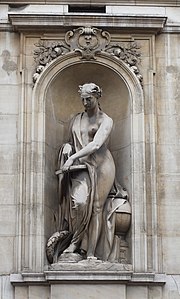Brussels Stock Exchange
 | |
 The former Brussels Stock Exchange building | |
| Type | Stock exchange |
|---|---|
| Location | Brussels, Belgium |
| Founded | 8 July 1801 |
| Owner | Euronext |
| Key people | Vincent Van Dessel (CEO) |
| Currency | EUR |
| No. of listings | 142[1] |
| Indices | BEL20 |
| Website | Official website |
The Brussels Stock Exchange (French: Bourse de Bruxelles; Dutch: Beurs van Brussel), abbreviated to BSE, was founded in Brussels, Belgium, by decree of Napoleon in 1801. In 2002, the BSE merged with the Amsterdam, Lisbon and Paris stock exchanges into Euronext, renaming the BSE Euronext Brussels. The most well known stock market index on the BSE is the BEL20.
The former Brussels Stock Exchange building (French: Palais de la Bourse; Dutch: Beurspaleis), usually shortened to Bourse or Beurs, is located on the Place de la Bourse/Beursplein along the Boulevard Anspach/Anspachlaan. This area is served by the premetro (underground tram) station Bourse/Beurs on lines 3 and 4.
History
[edit]Inception and construction
[edit]Created in 1801 by decree of Napoleon, the Stock Exchange (French: Bourse de Commerce) established in Brussels successively occupied different premises.[2] From 1858, a time when it experienced considerable development following the country's economic and industrial growth, the cramped and unsanitary conditions of the various premises led the business community to demand, from the municipal authorities, the erection of a new stock exchange.[3]

Following the covering of the river Senne for health and aesthetic reasons between 1867 and 1871, a massive programme of beautification of Brussels' city centre was undertaken. Having become a priority in the list of works of public utility, this undertaking gave rise, at the time, to numerous proposals including that of the architect Léon-Pierre Suys which, as part of his proposal to construct a series of grand boulevards in the river's place, designed a stock exchange building to become the centre of the rapidly expanding business sector.[3][4] Supported by several petitions, Suys' proposal won the support of the municipal council.[3]
The Brussels Stock Exchange (BSE) building was erected from 1868 to 1873, halfway down the newly created Boulevard Anspach/Anspachlaan (then called the Boulevard Central/Centraallaan), on the site of the former Butter Market (French: Marché au Beurre, Dutch: Botermarkt), itself built over the remains of the 13th-century Recollets Franciscan convent.[5][6][7] The building was inaugurated with a large ball in the presence of King Leopold II, his wife Queen Marie Henriette, and his brother Prince Philippe, Count of Flanders.[8] In parallel to these works, a large square, called the Place de la Bourse/Beursplein, was created in front of the building.[4]
Renovations and fire
[edit]Over the years, the Stock Exchange building underwent many renovations. Between 1930 and 1950, it was decided to increase the usable area and the incidence of light. On that occasion, a third floor was added and the central side walls on the Rue Henri Maus/Henri Mausstraat and the Rue de la Bourse/Beursstraat were opened up. The load-bearing parts of the building were also reinforced with reinforced concrete to support these renovations.
On the night of 29 November 1990, a fire broke out in one of the stockbrokers' cabins on the ground floor of the building, causing a lot of damage.[9] As a result, the BSE risked losing its financial activities and its reason for existence. Though the building was neatly restored, automation and acquisitions were already bringing an end to old market practices. In July 1996, all market floor activities disappeared. That year, the cash market was fully digitalised and the daily meeting of stockbrokers and traders therefore became redundant.[10][11]
Mergers, relocation and current usage
[edit]
In 1999, a first merger took place with CIK and BELFOX (BELgian Futures and Options Exchange). On 22 September 2000, the BSE merged again with Paris Bourse and the Amsterdam Stock Exchange to form Euronext, the first pan-European exchange for equities and derivatives, with common trading and clearing of all products, and was renamed Euronext Brussels.[12][10] In 2015, this company moved away from the Stock Exchange building, which had become too large, after the lease was broken by the City of Brussels in 2012.[13][14]
The vacated space was then occasionally opened to house temporary exhibitions of the City of Brussels. In the meantime, a competition was held about repurposing the Stock Exchange building. Renovations started in 2020 and plans were made to reopen the building as a museum of Belgian beer.[15] The winning design by Robbrecht & Daem, Baneton-Garrino and Popoff provided new space in the top two floors for the museum. The roof was converted into a panoramic bar with terrace, covered by a brass awning.[16] After three years of renovations, the Belgian Beer World museum was opened in September 2023.[17]
Building
[edit]The former Brussels Stock Exchange building does not have a distinct name, though it is usually called the Palais de la Bourse in French or the Beurspaleis in Dutch (or simply Bourse/Beurs, respectively), meaning "Stock Exchange Palace". It is located on the Boulevard Anspach/Anspachlaan, and is the namesake of the Place de la Bourse/Beursplein, which is, after the Grand-Place/Grote Markt, the second most important square in Brussels.

Exterior
[edit]The eclectic building, inspired by Palladian architecture, mixes borrowings from the neo-Renaissance and Second Empire styles.[18] It has an abundance of ornaments and sculptures, created by famous artists, including the brothers Jacques and Jean-Joseph Jacquet, the French sculptor Albert-Ernest Carrier-Belleuse and his then-assistant Auguste Rodin. Some of the best examples are the group of four allegorical figures on the façade by Guillaume de Groot, symbolising Art, Agriculture, Industry and Science, as well as the friezes by Carrier-Belleuse, in which Rodin may have contributed.[4]
Towards the boulevard, the two allegorical lion sculptures by Jacquet on each side of the main entrance's monumental staircase (one with its head facing up, the other curved back) represent the two symbolic stock market trends (akin to the famous "bull and bear" metaphor), as well as the Belgian Nation. They are accompanied by a genius with a torch by the same sculptor.[3][19]
A large arched skylight was pierced through the centre of the side façades by the architect Jules Brunfaut in 1893 in order to bring more light into the interior.[18]
- Brussels Stock Exchange's sculptures
-
Les arts ("Art")
-
L'agriculture ("Agriculture")
-
L'industrie ("Industry")
-
La science ("Science")
Interior
[edit]The interior, also inspired by Palladian plans, is a cruciform vessel supported by four monumental piers against which are attached Corinthian columns.[20][19] In the centre of the building, the main hall or salle des pas perdus (lit. 'room of the lost steps'), around which rooms and vestibules are arranged, is topped by a dome with a finial rooflight.[19]
The inside pediment separating the main hall from the entrance vestibule on the Rue du Midi/Zuidstraat includes four caryatids by Rodin and Antoine van Rasbourg, symbolising Protection, Trade, Art and Victory, with above them a globe carried by two putti.[21][19] The original light fixture supports were supplied at the time by the Compagnie des Bronzes de Bruxelles.[21]
-
Interior view of the main entry hall or salle des pas perdus
-
At the centre of the building looking upwards towards the dome
See also
[edit]References
[edit]Citations
[edit]- ^ "Product directory | Euronext Live cours de bourse". live.euronext.com. Retrieved 15 February 2024.
- ^ Demey 2013, p. 550.
- ^ a b c d Mardaga 1989, p. 52.
- ^ a b c Eggericx 1997, p. 27.
- ^ Eggericx 1997, p. 26–28.
- ^ Demey 2013, p. 551.
- ^ Gérard 2023, p. 20.
- ^ Demey 1990.
- ^ Thierry Wilmotte and Jean-François Lanckmans, Le feu à la Bourse, Le Soir (in French), 30 November 1990
- ^ a b "Euronext Bruxelles a dix ans… et se cherche un avenir". L'Echo (in French). 20 September 2010. Retrieved 15 February 2024.
- ^ "La Bourse de Bruxelles, futur "temple" de la bière belge". Le Soir (in French). 20 June 2013. Retrieved 15 February 2024.
- ^ Théodore, Jean-François (22 September 2000). "Birth of Euronext: Speech from Jean-François Théodore, Chairman and Chief Executive Officer of Euronext". Paris Europlace. Archived from the original on 12 March 2016. Retrieved 27 December 2013.
- ^ "Beurs verhuisd: 'Buurt niet meer geschikt voor business'". www.bruzz.be (in Dutch). Retrieved 24 May 2020.
- ^ "Euronext Brussel verhuist naar Markiesgebouw". De Tijd (in Dutch). 23 February 2016. Retrieved 24 May 2020.
- ^ Chini, Maïthé (19 February 2020). "Brussels Bourse building to be transformed into Beer Museum". The Brussels Times. Retrieved 30 September 2023.
- ^ "Architecten lanceren communicatieoffensief voor Beursrenovatie". www.bruzz.be (in Dutch). Retrieved 17 November 2021.
- ^ Walker, Lauren (7 September 2023). "A first look inside the renovated Bourse and the Belgian Beer World". The Brussels Times. Retrieved 30 September 2023.
- ^ a b Demey 2013, p. 552.
- ^ a b c d Demey 2013, p. 553.
- ^ Mardaga 1989, p. 54.
- ^ a b Mardaga 1989, p. 56.
Bibliography
[edit]- Demey, Thierry (1990). Bruxelles, chronique d'une capitale en chantier (in French). Vol. I: Du voûtement de la Senne à la jonction Nord-Midi. Brussels: Paul Legrain/CFC. OCLC 44643865.
- Demey, Thierry (2013). Bruxelles, des remparts aux boulevards (in French). Brussels: Badeaux. ISBN 978-2-930609-02-7.
- Eggericx, Laure (1997). Les Boulevards du Centre. Bruxelles, ville d'Art et d'Histoire (in French). Vol. 20. Brussels: Centre d'information, de Documentation et d'Etude du Patrimoine.
- Gérard, Hervé (2023). Bruxelles et ses places (in French). Brussels: 180° éditions. ISBN 978-2-940721-32-0.
- Le Patrimoine monumental de la Belgique: Bruxelles (PDF) (in French). Vol. 1A: Pentagone A-D. Liège: Pierre Mardaga. 1989.
Further reading
[edit]- Buelens, Frans; De Smedt, Helma; Willems, Hans (2014). "The (De)regulation of the Brussels Stock Exchange around 1865–1875". Bankhistorisches Archiv (1–2): 3–22.
- Poukens, Johan; Buelens, Frans (2022). "Stock exchange regulation and the official price lists of the stock exchanges of Brussels and Antwerp, 1801–1935". Financial History Review. 29: 1–16.
External links
[edit] Media related to La Bourse/De Beurs at Wikimedia Commons
Media related to La Bourse/De Beurs at Wikimedia Commons- Official website
- Buildings and structures in Brussels
- City of Brussels
- Economy of Brussels
- Euronext national listing venues
- Defunct stock exchanges
- Office buildings in Belgium
- Companies based in Brussels
- Stock exchange buildings
- Second Empire architecture
- Beaux-Arts architecture
- 1801 establishments in France
- 2000 disestablishments in Belgium







![Interior pediment with caryatids by Auguste Rodin and Antoine van Rasbourg [nl]](http://upload.wikimedia.org/wikipedia/commons/thumb/b/b7/Bruxelles%2C_Palais_de_la_Bourse_et_Cariatides%2C_journ%C3%A9es_du_Patrimoine_-_panoramio.jpg/181px-Bruxelles%2C_Palais_de_la_Bourse_et_Cariatides%2C_journ%C3%A9es_du_Patrimoine_-_panoramio.jpg)
